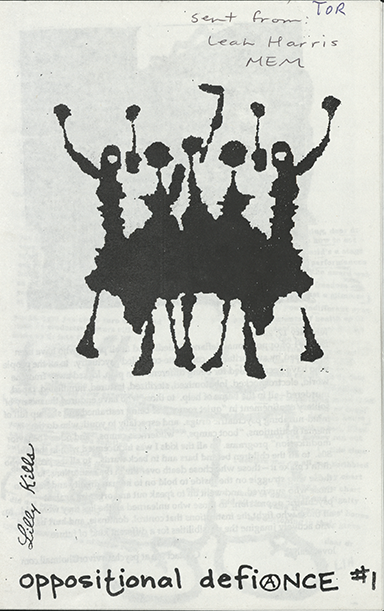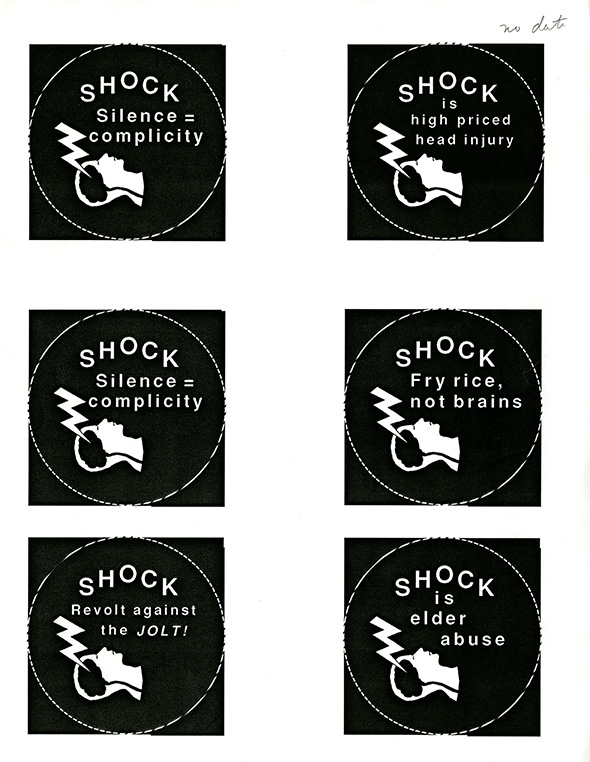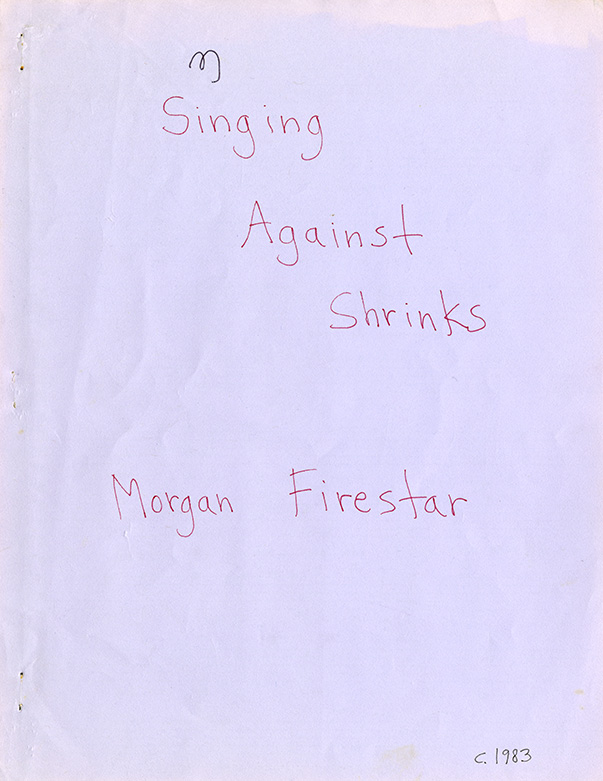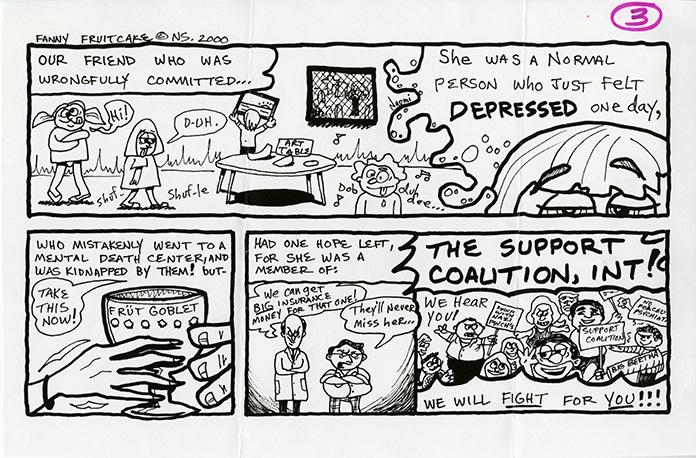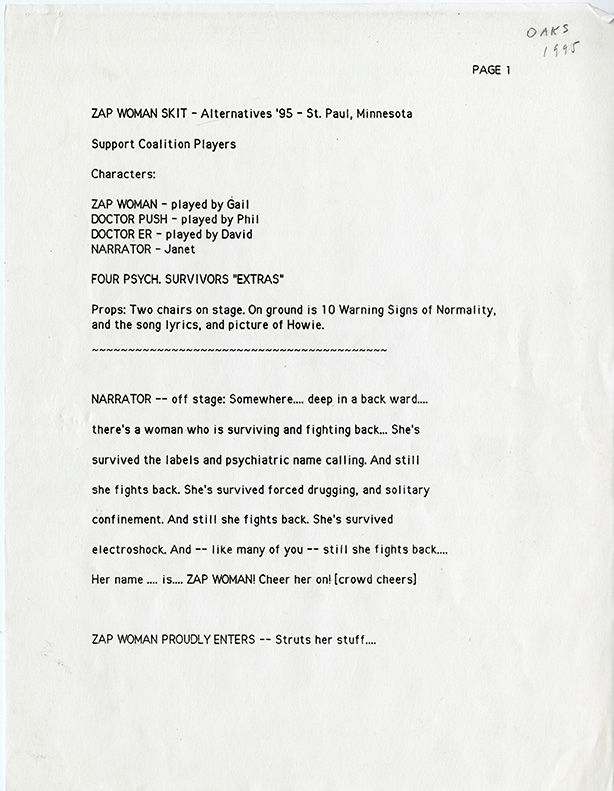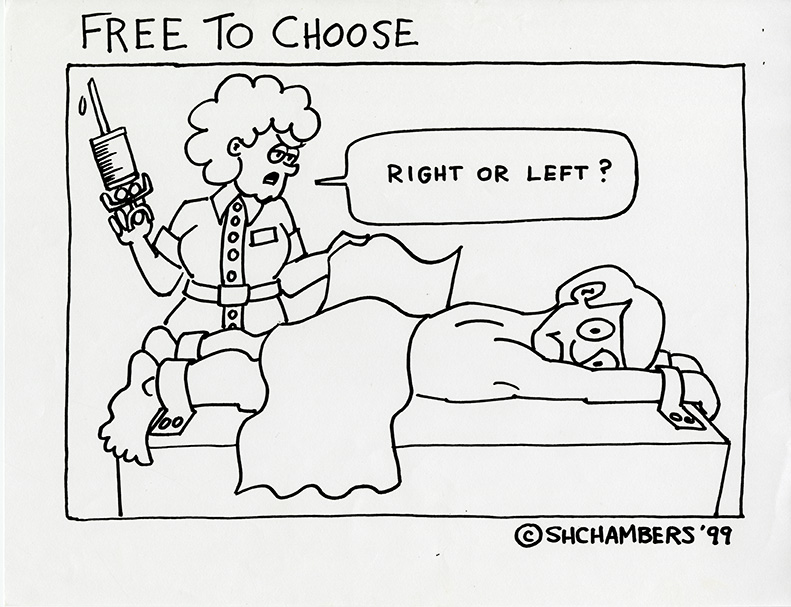Fostering a Culture of Empowerment in Mental Health Care
Selections from the MindFreedom International Records
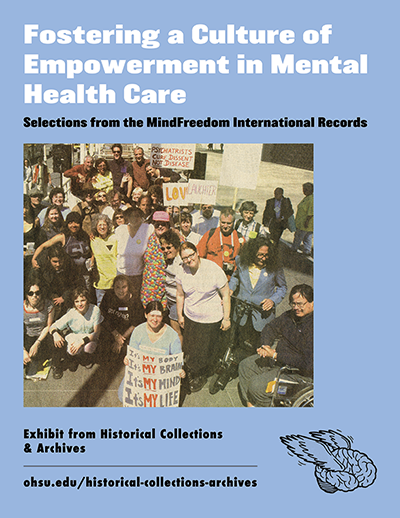
Content advisory: This exhibit includes themes of mental health, ableism, and abuse in the mental health care system.
The psychiatric survivors movement emerged from the social unrest and civil rights movements of the late 1960s and early 1970s among people who had experienced human rights violations in the mental health care system. The movement calls attention to the need for self-determination for users of mental health services, and supports advocates in uniting under the banner of "Mad Pride" to affirm their personhood. Psychiatry has been criticized for its view of patients as objects to be assessed, diagnosed, and treated. The psychiatric survivors movement, and more specifically the organization MindFreedom International, has empowered individuals to claim their subjectivity and right to make decisions involving their mental health.
Drawing from the MindFreedom International Records, this exhibit highlights the ways in which activists created space and built community in the psychiatric survivors and Mad Pride movements. Including survivor-led publications, event flyers, art, and photographs, the exhibit examines concepts of resisting control and advocating for choice in mental health treatment.
Curated by Zoë Maughan, Archives Assistant. Last updated August 2022.
Creating space
MindFreedom International roots
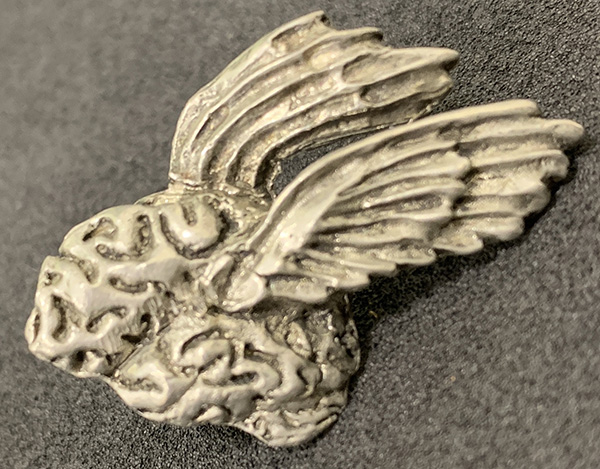
David Oaks first encountered the mental health system when he was a student at Harvard University in the mid-1970s. While a student, he faced emotional crises and experienced psychiatric institutionalization, involuntary drugging, and solitary confinement. A referral during his senior year to the Mental Patients Liberation Front, one of the first volunteer organizations of psychiatric survivors, led Oaks to become increasingly involved with the psychiatric survivors and Mad Pride movements. He began working with grassroots organizations, including the Mental Health Patients Liberation Front, the Network Against Psychiatric Abuse, and the National Assocation for Rights Protection and Advocacy to raise awareness about psychiatric oppression and to advocate for choice and alternatives in mental health care.
In 1986, Oaks established a nonprofit project with start-up funding from the Levinson Foundation. The purpose was to publish a newsletter and provide a “Clearinghouse on Human Rights & Psychiatry.” The creation of the newsletter Dendron took place at a significant time in the movement. Madness Network News, a prominent newsletter in the movement, had recently ceased publication. The first issue of Dendron was published in January 1988 and the newsletter gradually grew to facilitate crucial movement communication. Oaks served as the editor.
In May 1990, Dendron sponsored a counter-conference and protest of the American Psychiatric Assocation Annual Meeting. Following the event, multiple grassroots groups united to form a new coalition, Support Coalition International (SCI). The majority of the membership was made up of psychiatric survivors, but anyone supporting the coalition’s human rights goals was welcome to join. The organization operated as two nonprofits, Support Coalition Northwest and Support Coalition International, until August 2005, when they merged under the name MindFreedom International.
MindFreedom International unites grassroots groups to win human rights and alternatives for people labeled with psychiatric disabilities. The organization has four primary goals: winning human rights in mental health, challenging systemic psychiatric abuse, supporting the self-determination of survivors and mental health consumers, and advocating for safe and humane treatments options in mental health care. Activists in the psychiatric survivors movement asserted that psychiatry’s medicalization of mental health is harmful and emphasized the crucial role of independent organizing to challenge psychiatric oppression.
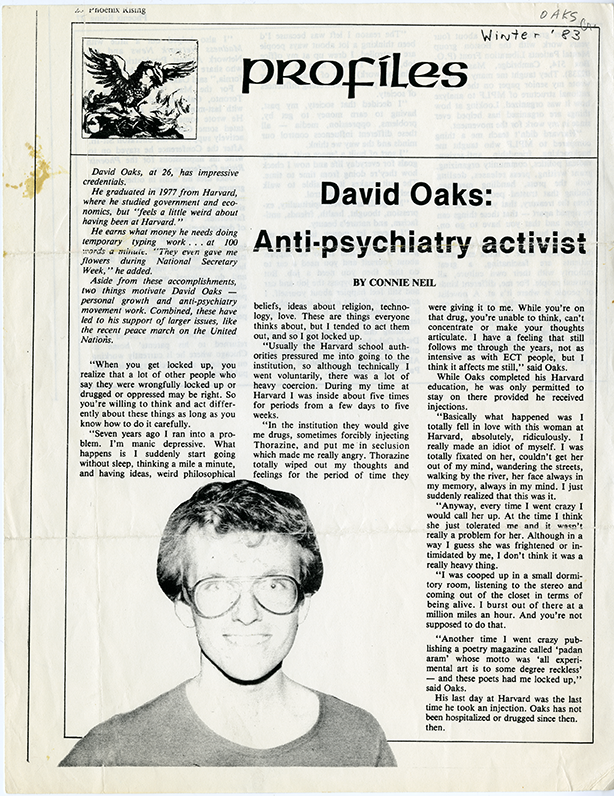
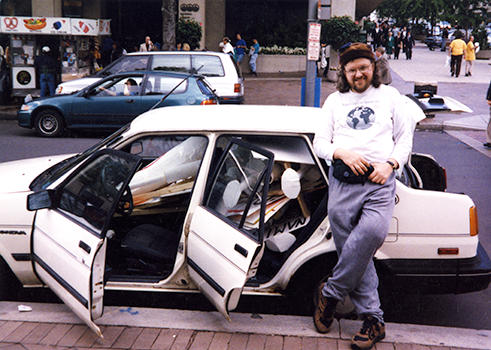
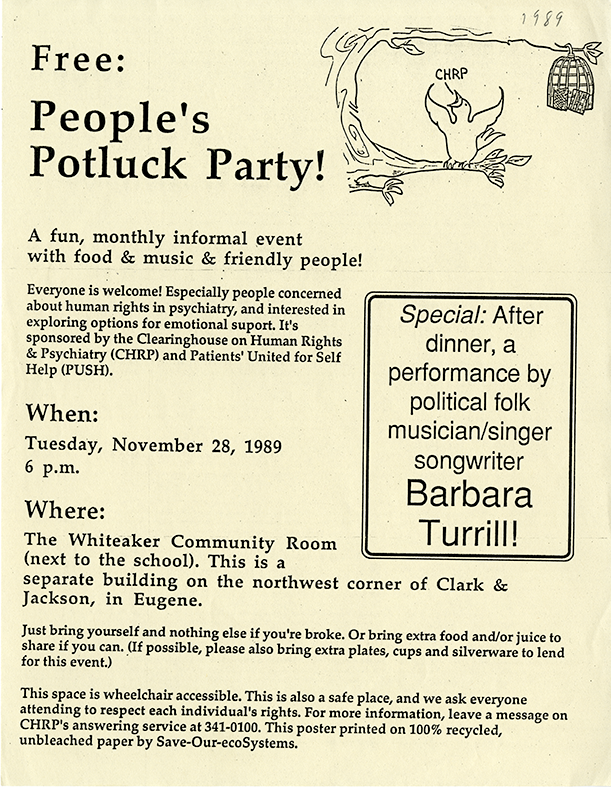
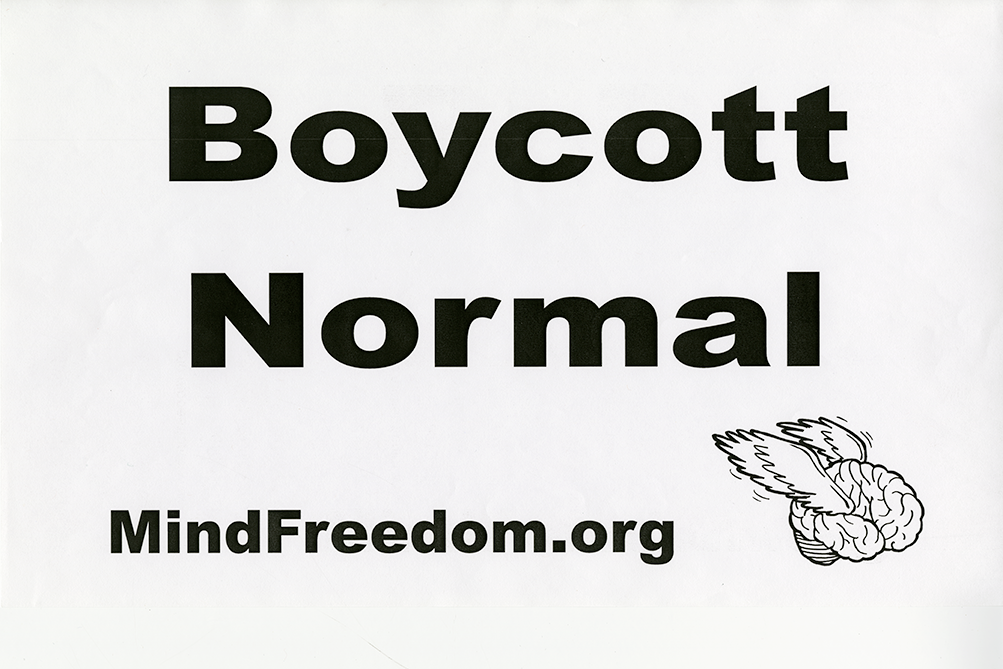
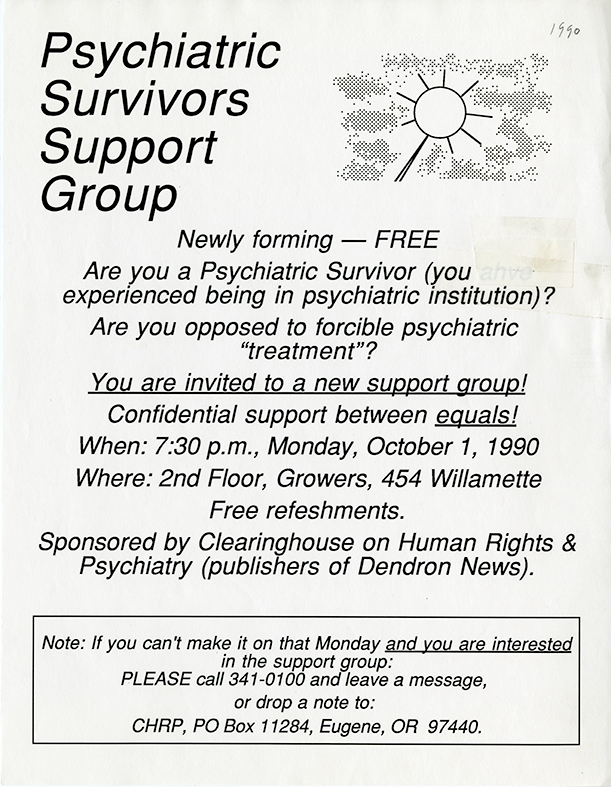
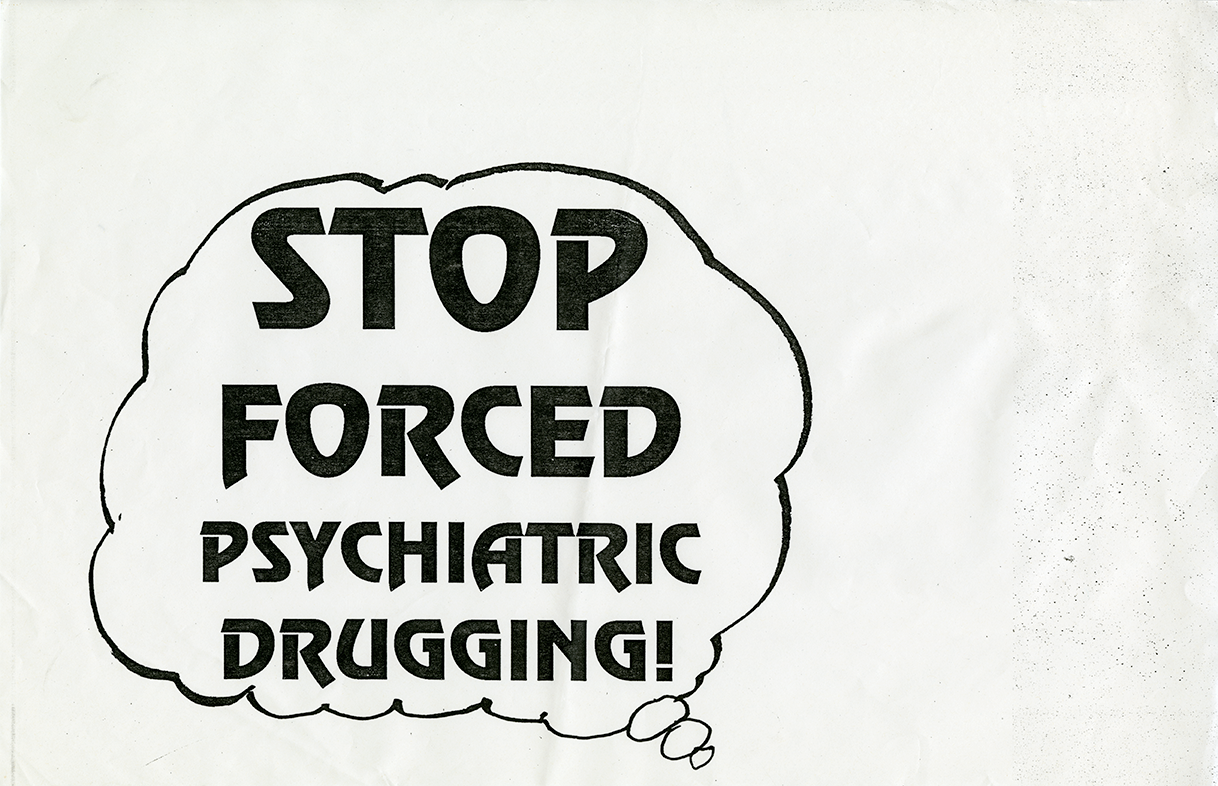
Protesting the American Psychiatric Association
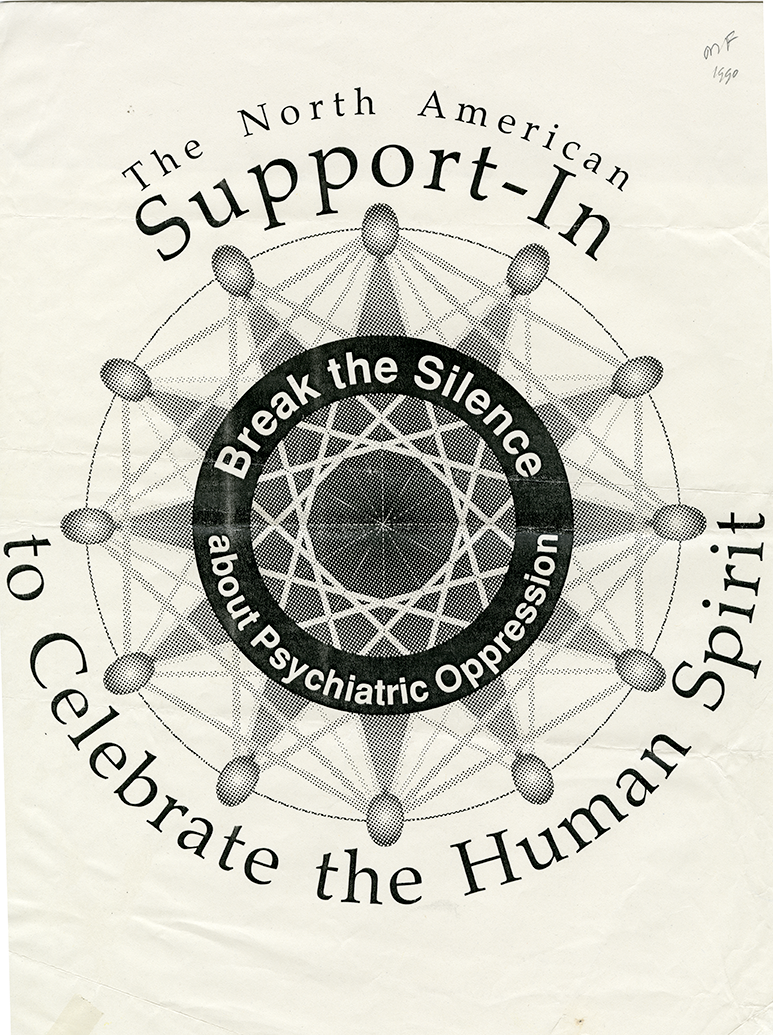
Support Coalition International, the organization which would grow into MindFreedom International, was the result of the inevitable banding together of multiple grassroots mental health advocacy organizations. In May of 1990, Dendron sponsored a counter-conference and protest of the American Psychiatric Assocation Annual Meeting, held in New York City. Formally titled the “North American Support-In to Celebrate the Human Spirit and Break the Silence About Psychiatric Oppression,” this was the first time that grassroots groups formed an ongoing coalition at the protest.
The Support-In was organized by about thirty individuals across the US. While protests of the annual meeting were an established practice, the inclusion of a counter-conference was new. The stated goal of the Support-In was to break the silence surrounding forced institutionalization and drugging, electroshock, lobotomy, and unfounded genetic theories and to promote human rights and alternatives to forced psychiatric procedures. Events on the 1990 Support-In counter-conference schedule included “A Critique of the Myths of the Mental Health Establishment,” “Psychiatric Racism,” “Disability Rights," and “Gays’ and Lesbians’ Issues: Choices.” Similar, smaller Support-Ins were held concurrently in Alabama, Colorado, California, Oregon, Michigan, and Toronto, Canada.
The Support-In was not limited to a one-time event; it continued a tradition of protesting the APA Annual Meeting and promoting alternatives in a counter-conference, including events featured here from 1992 in Washington, D.C. and 1997 in San Diego. In organizing these protests and uniting grassroots organizations, psychiatric survivors made space for themselves where they had historically been excluded. These events raised awareness for the movement and facilitated community building. The 1990 Support-In led to the unification of many grassroots groups who then founded Support Coalition International. The creation of the coalition facilitated networking and organizing on local and global scales. In 2005, Support Coalition International became MindFreedom International.
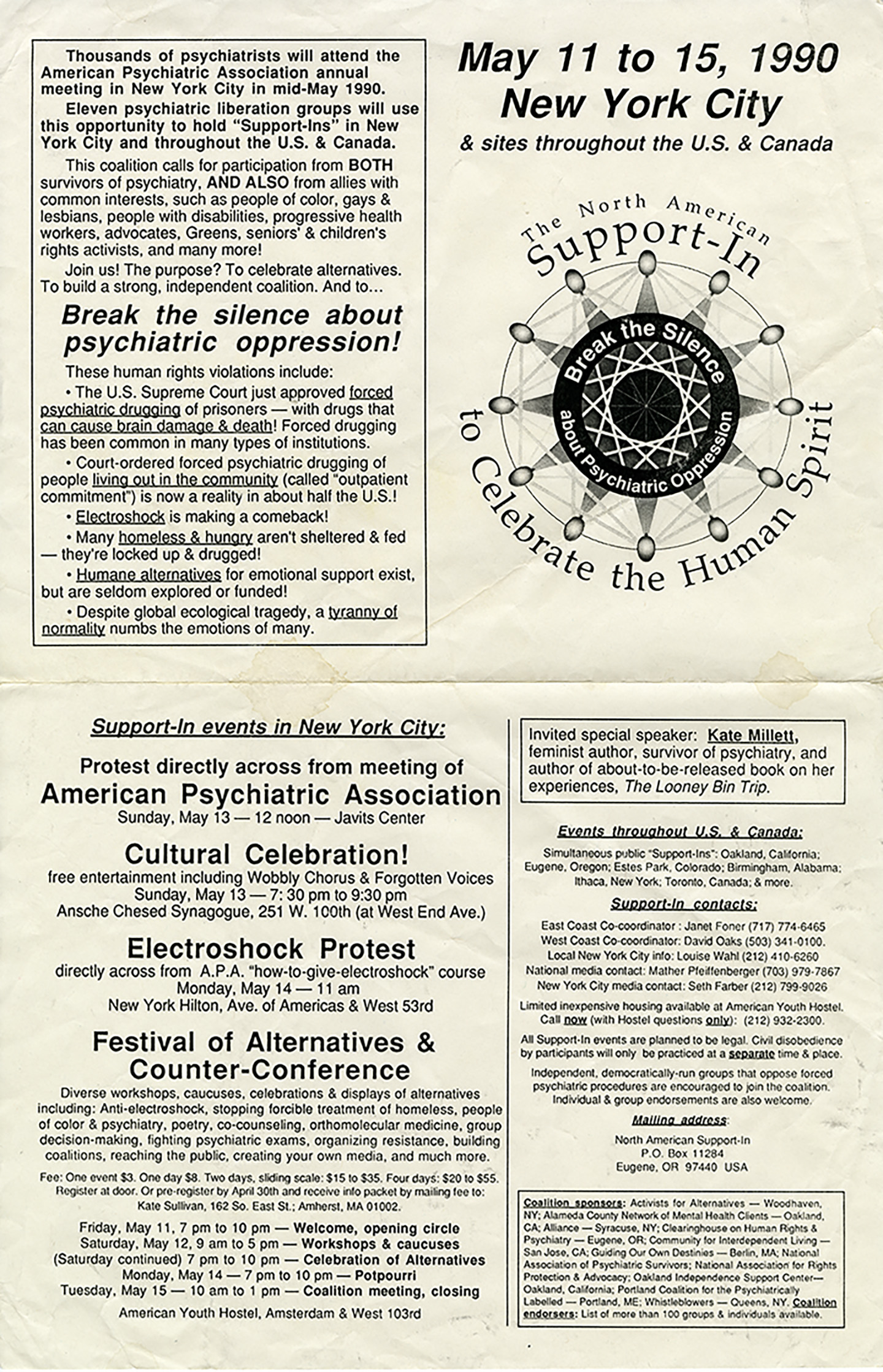
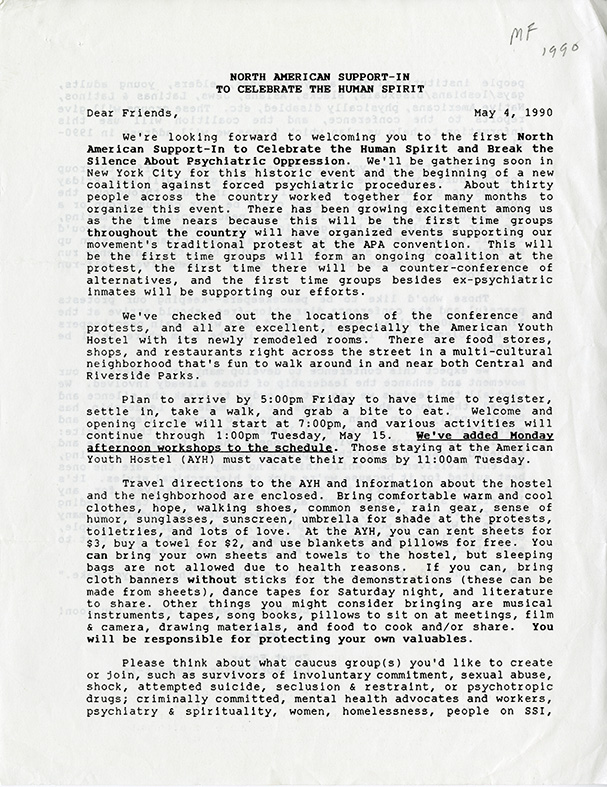
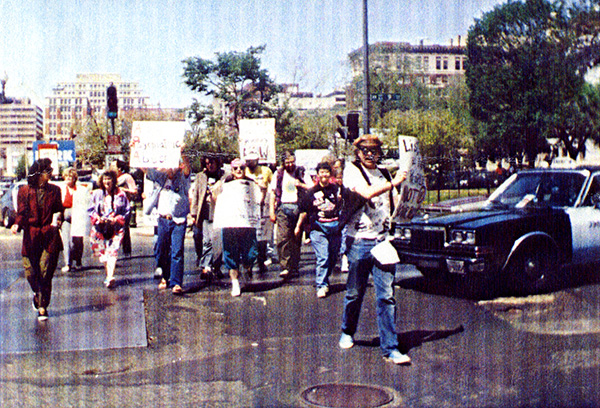
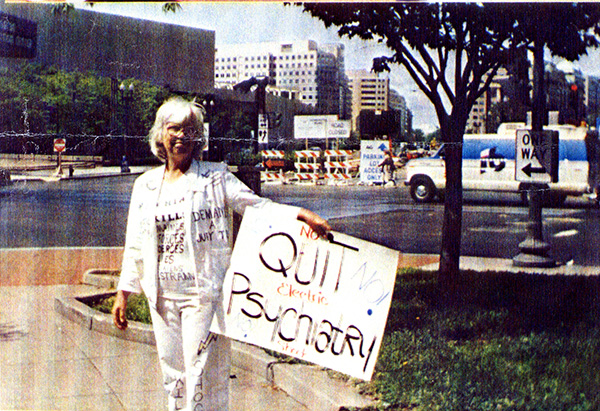
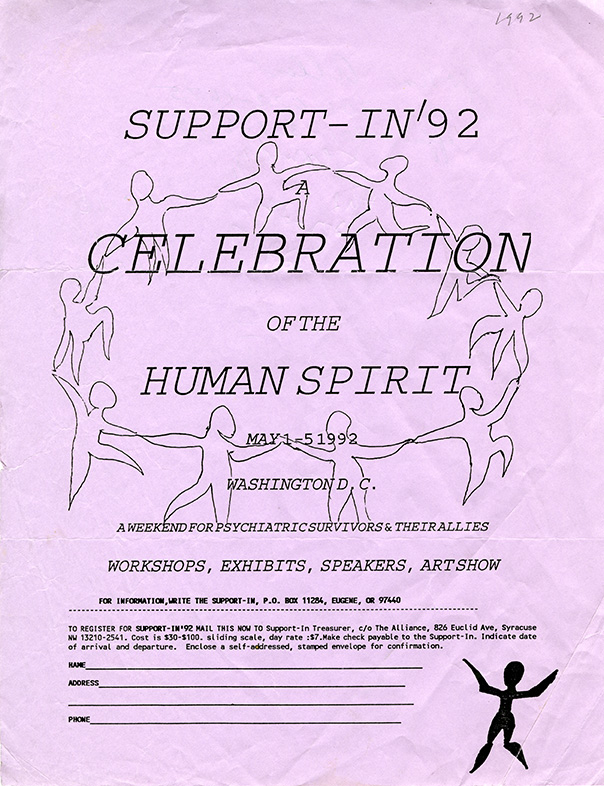
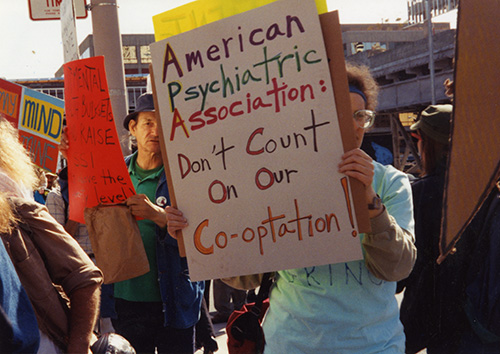
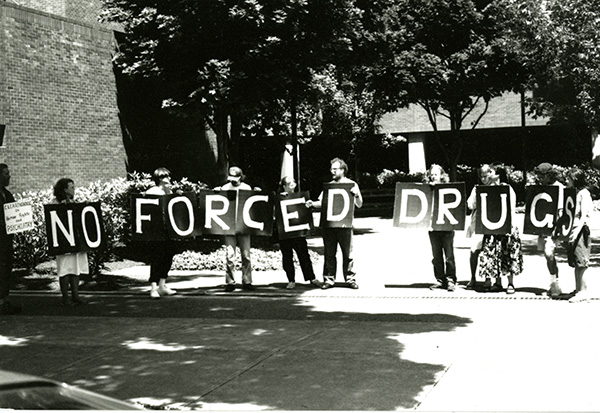
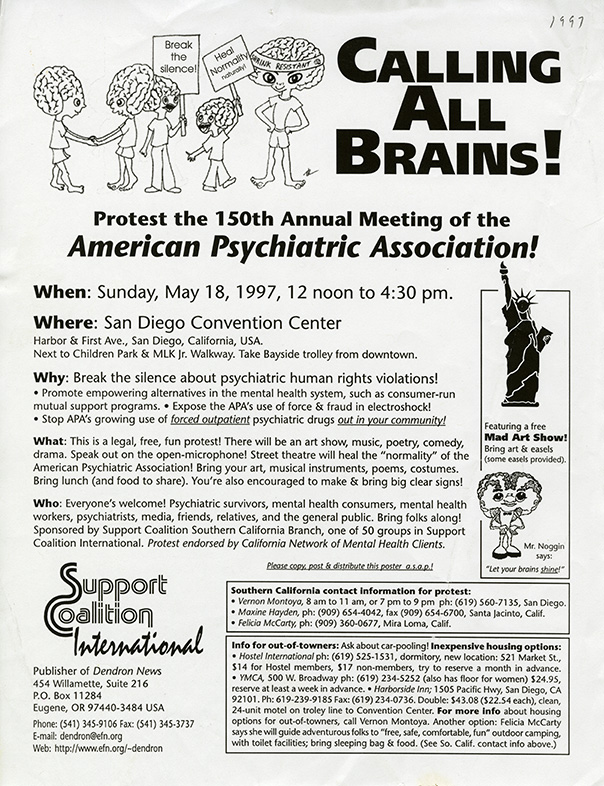
Building community
Networking newsletters
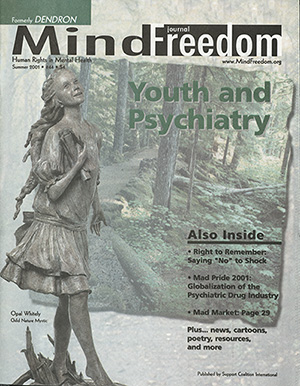
Survivor-led publications served as a medium for raising awareness, establishing and building community, and claiming space for survivor voices. The consistent distribution of a networking newsletter, from Dendron to MindFreedom Journal, helped MindFreedom International to build and maintain its community. Publications were a vital tool for community building and organizing. Dendron was influenced by and collaborated with multiple psychiatric survivors movement publications. Notable newsletters and journals include Madness Network News, Mental Patients Liberation Front Journal, Phoenix Rising, State and Mind, and NAPS/NEWS. Madness Network News, a successful San Francisco-area newsletter that grew to cover worldwide developments in the movement, was published from 1972 until 1985. When it ceased publication, the incoming Dendron worked to facilitate and maintain movement communications.
Newsletters and journals helped psychiatric survivors and allies to foster community, stay up to date with the movement, and organize prior to the widespread use of the internet for communication. Survivor-led publications challenged dominant narratives put forth by the psychiatry, critiquing the medical model of mental illness and emphasizing the subjectivity of ex-patient experiences. Newsletters and journals centered personal narrative, publishing stories, letters, art, and more. Rather than objects acted upon by psychiatry, survivors affirmed their subjectivity. They recognized that recovery requires empowerment and that empowerment is born out of mutual support. Psychiatric survivor newsletters and journals were crucial tools for centering survivor voices, building community, and empowering psychiatric patients and survivors.
First published with start-up funds from the Levinson Foundation in 1988, Dendron was an ex-patient newsletter edited by David Oaks. Described as an information service, this newsletter existed to keep the community informed of movement news and to facilitate networking. The establishment of Dendron was a crucial step in the effort to create an independent human rights coalition focused on rights in mental health.
Subscription card and information for Dendron, 1987. MindFreedom International records [2013-026].
Dendron News created space to explore options humane emotional support and fostered community in the psychiatric survivors movement. This flyer was an invitation to join the Dendron community.
In 2001, Dendron News was renamed MindFreedom Journal. Like Dendron, MindFreedom Journal facilitated networking and centered survivor voices in discussions of mental health care. MindFreedom Journal continued in active publication until 2011, and in combination with Dendron, resulted in more than 50 volumes. Issue themes included Youth and Psychiatry, Electroshock’s Secret Comeback, and Freedom of Choice in Mental Health.
The contents of this Fall 1977 issue include three psychiatric survivor autobiographies, a poetry feature, and information about MPLF meetings. David Oaks appears in the credits for putting this issue together.
The Mental Patients Liberation Front (MPLF), based in Boston, was one of the first patients’ rights organizations that David Oaks joined. Prominent movement leader Judi Chamberlin was an active member of MPLF. This community fostered Oaks’ advocacy, leading to the Clearinghouse on Human Rights and Psychiatry, Support Coalition International, and eventually, MindFreedom International. The last page of this newsletter advertises weekly MPLF meetings, stating, “we welcome new people and new ideas.”
Judi Chamberlin's papers, which include additional materials related to the Mental Patients Liberation Front and the psychiatric survivors movement, are housed at University of Massachusetts Amherst, with many materials available online. Explore the collection at UMass Amherst Libraries.
The central theme of this Fall 1981 issue of the Toronto-based publication, Phoenix Rising, is “The Movement” and features a review of the activities of the psychiatric survivors movement in Europe and North America, including various organizational contact details and regional events.
Additional digitized issues of Phoenix Rising can be viewed online via the Madness Canada project.
The cover of this Fall 1980 Madness Network News issue features Members of the 8th Annual Conference on Human Rights and Psychiatric Oppression, including David Oaks, blocking the entrance to the meeting of the American Psychiatric Association. Protests such as these laid the groundwork for later Support-In activities.
Before it was State and Mind, this publication was known as The Radical Therapist and then Rough Times. This issue of State and Mind, from the fall of 1977, features the theme of Normalization. The featured article in this issue discusses “how the growing power of psychiatry sets standards of normalcy for all aspects of our lives.” Publications like State and Mind created space and community for their readers by dedicating space to publishing letters sent to the publication.
NAPS/NEWS, 1990. MindFreedom International records [2013-026]. Online via OHSU Digital Collections.
This Spring 1990 issue of the National Association of Psychiatric Survivors News features a recap of the 1990 Support-In. NAPS/NEWS was published by the National Association of Psychiatric Survivors based in Sioux Falls, South Dakota.
Advocacy through art
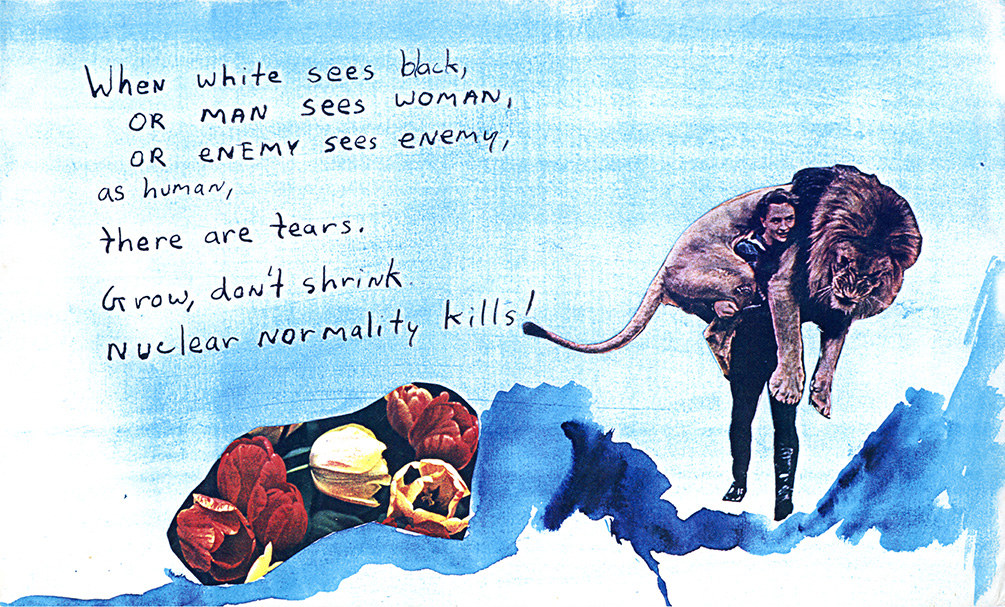
Creative expression was another way psychiatric survivors resisted control and advocated for choice. Psychiatric survivors claimed space for the subjectivity of their experiences and expressed Mad Pride through a wide variety of artistic mediums, including visual art, narrative, poetry, music, theater, and zines. A common thread that unites much of the art in these records is the use of humor and irony as a lens to critique psychiatry. In the face of suffering, psychiatric survivors created art that affirmed their humanity, recognized their shared experiences, and challenged psychiatric oppression. MindFreedom International championed creative expression as one of many alternative mental health care options.
MindFreedom International received and collected a wide variety of survivor art over time, with many pieces appearing in Dendron and MindFreedom Journal. Visual art, especially cartoons, was often reproduced by the organization for event posters, buttons, and t-shirts. In centering survivors’ experiences, this art drew attention to the crucial issues that were going unacknowledged in mental health treatment, from forced institutionalization and drugging to electroshock. Artists used a wide variety of approaches, from humor to outrage, to draw attention to human rights violations in mental health treatment and to advocate for reform. Advocacy through art allowed psychiatric survivors to share their experiences and create meaningful bonds with others. The existence of this art affirmed the message: you are not alone. These works of art also demonstrate the ways in which mental health advocacy intersects with social issues of race, gender, sexuality, and ability, as well as environmental advocacy.
